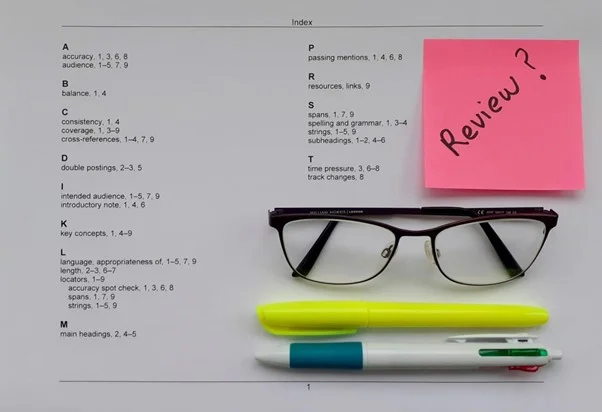How to evaluate an index: guidance for authors and editors

When you have commissioned an index for your book, either directly or via your publisher, there should be a moment towards the end of the book production process where you are asked to review the index. In the third and final post in this series, Lyndsay Marshall takes you through the process of evaluating your index.
Reviewing your index: factors to consider
Here are some key elements to look for. By working through this list, you will know whether the index fulfils its main purpose, which is to help your readers find material easily and quickly. Checking your index should not take more than an hour or two.
- Themes and concepts. As the author or editor, you will be familiar with the main themes of your book. Approach the index with a list of key concepts and check that they are present. If not, make a note to discuss this with your indexer; the concept might have been named slightly differently than you are expecting, and you can discuss together how to tweak the index to clarify it.
- Word choice. Has the indexer used words that are appropriate for the intended audience of your book? (E.g. ‘wrist joints’ in a book for general readers and ‘radiocarpal joints’ for medical professionals.) Does it match the terminology that you have used within the book?
- Page numbers (locators):
- Strings. The list of locators next to each heading or subheading should not exceed 5–7 in a string. Subheadings should have been used to analyse topics that appear more often.
- Passing mentions should not have been included in the list of locators. Passing mentions include brief, repeated mentions of material discussed more fully elsewhere.
- Long page ranges (spans) (e.g. 36–49) might have been included at a main heading to indicate the extent of coverage of that topic, but subheadings should follow to help the reader navigate within the topic. As a general rule, long spans should be avoided if possible.
- A spot-check of locators is a good way to check the accuracy of the index. Look up a selection of page references and make sure the topic listed is discussed at the location indicated.
- Subheadings:
- Prepositions. There should not be excessive use of prepositions (on, of, to, with etc) or articles (a, an, the) although some might have been added to clarify the relationship between the subheading and main heading, which should be clear and logical.
- The grammatical structure of the subheadings should be consistent throughout the index (e.g. ‘prices’ should not change to ‘pricing’ in other entries within the same index).
- Check the locators within a set of subheadings. If many of the same locators have been repeated, it is a sign that the analysis of the topic might need to be revisited.
- Cross-references. These should work correctly:
- A ‘see’ cross-reference will point from an alternative term for a concept towards the preferred term (usually the one used most frequently in the text (e.g. ‘domestic labour see housework’).
- A ‘see also’ reference will lead to related topics with relevant and additional information (e.g. ‘collage see also bricolage’).
- Double postings will often be present in the index too, where two different terms for a topic have been included with the same locators at each entry (e.g. ‘walking frames’ and ‘Zimmer frames’).
Dealing with queries
What should you do with your review queries? Discussing the queries with your indexer is really important. The indexer can explain their decisions, and they can also be guided by your knowledge of their topic and make changes as required. Extensive changes probably won’t be possible at this stage due to the tight turnaround times for review. However, these are rarely necessary where indexing requirements have been clearly defined at the beginning of the indexing process. If minor changes are required, they should be made by the indexer. They have the software to do this easily and will ensure that there aren’t any unexpected knock-on effects to the index structure.
Further information
Commissioning an Index: a guide from the Society of Indexers
The American Society of Indexers’ evaluation checklist
Mulvany, Nancy C. Indexing Books (University of Chicago Press, 2005)
If this has inspired you to learn more about indexing, there are workshops available from the Society of Indexers including Indexing Basics which provides an overview of the indexing process and an introduction to basic principles.
There are various indexing and publishing industry blog posts on this topic:
- from SI members Tanya Izzard and Paula Clarke Bain, and Melanie Gee
- by Cathy Hannabach at Ideas on Fire
- by Helen Kara, from an author’s perspective
- by Steve Ingle, for the Textbook and Academic Authors Association
About Lyndsay Marshall
Lyndsay Marshall indexes academic books in literary studies, cultural studies, theology, religious studies, and the social sciences, producing standard and embedded indexes. She is an Advanced Professional Member of SI, a member of the Marketing Working Group and Minutes Secretary for the Executive Board.


